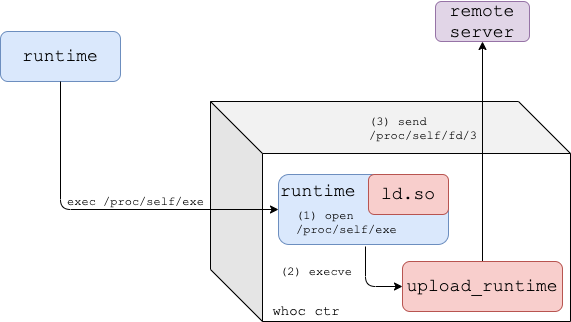Whoc - A Container Image That Extracts The Underlying Container Runtime
A container image that extracts the underlying container runtime and sends it to a remote server. Poke at the underlying container runtime of your favorite CSP container platform!
- WhoC at Defcon 29 Cloud Village
- Azurescape - whoc-powered research, the first cross-account container takeover in the public cloud (70,000$ bounty)

As shown by runc CVE-2019-5736, traditional Linux container runtimes expose themselves to the containers they're running through /proc/self/exe. whoc uses this link to read the container runtime executing it.
Dynamic Mode
This is whoc default mode that works against dynamically linked container runtimes.
- The
whocimage entrypoint is set to/proc/self/exe, and the image's dynamic linker (ld.so) is replaced withfake_ld. - Once the image is run, the container runtime re-executes itself inside the container.
- Given the runtime is dynamically linked, the kernel loads our fake dynamic linker to the runtime process and passes execution to it.
fake_ldobtains a file descriptor for the runtime binary by opening/proc/self/exe, and executesupload_runtime.upload_runtimereads the runtime binary from/proc/self/fd/<runtime-fd>and sends it to the configured remote server.
For statically linked container runtimes, whoc comes in another flavor: whoc:waitforexec.
upload_runtimeis the image entrypoint, and runs as thewhoccontainer PID 1.- The user is expected to exec into the
whoccontainer and invoke a file pointing to/proc/self/exe(e.g.docker exec whoc-ctr /proc/self/exe) - Once the exec occurs, the container runtime re-executes itself inside the container
upload_runtimereads the runtime binary through/proc/<runtime-pid>/exeand sends it to the configured remote server
You'll need docker and python3 installed. Clone the repository:
$ git clone git@github.com:twistlock/whoc.gitSet up a file server to receive the extracted container runtime:
$ cd whoc
$ mkdir -p stash && cd stash
$ ln -s ../util/fileserver.py fileserver
$ ./fileserverFrom another shell, run the whoc image in your container environment of choice, for example Docker:
$ cd whoc
$ docker build -f Dockerfile_dynamic -t whoc:latest src # or ./util/build.sh
$ docker run --rm -it --net=host whoc:latest 127.0.0.1 # or ./util/run_local.shSee that the file server received the container runtime. Since we run whoc under vanilla Docker, the received container runtime should be runc.
--net=host is only used in local tests so that the whoc container could easily reach the fileserver on the host via 127.0.0.1.
Help
Help for whoc's main binary, upload_runtime:
Usage: upload_runtime [options] <server_ip>
Options:
-p, --port Port of remote server, defaults to 8080
-e, --exec Wait-for-exec mode for static container runtimes, waits until an exec to the container occurred
-b, --exec-bin In exec mode, overrides the default binary created for the exec, default is /bin/enter
-a, --exec-extra-argument In exec mode, pass an additional argument to the runtime so it won't exit quickly
-r, --exec-readdir-proc In exec mode, instead of guessing the runtime pid (which gives whoc one shot of catching the runtime),
find the runtime by searching for new processes under '/proc'
 Reviewed by Zion3R
on
8:30 AM
Rating:
Reviewed by Zion3R
on
8:30 AM
Rating:










